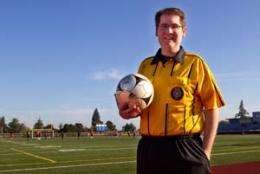New incision-free surgery helps tame chronic acid reflux

(Medical Xpress) -- Adam Vasser would wake up at night choking on partially digested food and liquid. Stomach acid burned the delicate tissue of his throat. “I’d sleep really badly,” he said.
During the day, he sometimes suffered from heartburn.
The 27-year-old Los Altos, Calif., resident has since become the first patient at Stanford Hospital & Clinics to undergo a new, incision-free surgery to manage his gastroesophageal reflux disease, also known as chronic acid reflux.
Having had a heart transplant as a teenager, Vasser decided that the scarless surgery, performed though the mouth and throat, was the best option for him; internal scarring from his earlier operation could have complicated a traditional open chest or laparoscopic surgery, which involves inserting instruments through several abdominal incisions.
“Scar tissue left over from previous operations is less pliable and easy to manipulate,” said John Morton, MD, MPH, chief of minimally invasive surgery at Stanford Hospital. “It also increases the risk of blood leakage. None of this would have precluded us from carrying out a traditional operation, but it would have taken longer and introduced those possible risks.”
Chronic acid reflux is common. Approximately 10 to 20 percent of people living in the Western world suffer at least weekly from heartburn or the regurgitation of stomach acid, according to a 2005 review in the journal Gut. The problem occurs when the lower esophageal sphincter, a band of muscle at the bottom of the esophagus that keeps the contents of the stomach from going back up, weakens or stops working altogether. In addition to the discomfort it causes, the regular flow of gastric acid into the esophagus may eventually lead to an ulcer, a painful open sore.
A variety of medications — including proton-pump inhibitors, which reduce the production of stomach acid — kept Vasser’s reflux symptoms in check for more than a decade. In 2010, however, the efficacy of those medications began to wane, and his symptoms returned with a vengeance.
At the prompting of his gastroenterologist, he turned to Morton, one of the country’s leading specialists in weight-loss surgery and an expert in minimally invasive procedures, who suggested the incisionless operation to recreate a natural anti-reflux barrier.
The operation involves using a new device, the EsophyX, that looks like a high-tech fishing pole. With the patient under general anesthesia, the flexible rod is inserted through the mouth and throat until it reaches the stomach. There, a small, retractable wire grabs a 1- to 2-inch section of the stomach wall and pulls it down. The two sides of the resulting flap are then pressed together and shaped with the help of a tissue mold and held in place with plastic fasteners.
The process is repeated on adjoining sections of stomach wall until a 270- to 310-degree semi-circular valve is formed just beneath the lower esophagus. The valve looks like a three-dimensional omega.
A 2008 study of 86 patients published in the World Journal of Surgery concluded that the EsophyX “was safe and effective in improving quality of life and for reducing symptoms.” A year after surgery, 81 percent of the patients were able to stop using proton-pump inhibitors completely, the study said.
The study also said that 56 percent of patients were cured, based on their discontinuation of the medication and the reduction of symptoms. The most common adverse side effect was pain in the left shoulder. This affected 18 percent of patients in the study. Other side effects included abdominal pain (15 percent), sore throat (8 percent) and nausea (8 percent). In practically all cases, these side effects lasted no longer than a month.
Although Vasser was the first patient to undergo the EsophyX treatment at Stanford Hospital, it has been done at a few dozen other hospitals around the country and more extensively in Europe.
On Aug. 4, Vasser underwent the operation. Homero Rivas, MD, MBA, a leader in natural orifice and single-incision surgery, and Pankaj Jay Pasricha, MD, chief of the Gastroenterology and Hepatology Division at Stanford, assisted Morton.
Vasser left the hospital less than 24 hours later. “I had a sore throat for a few days afterward, but that was all,” he said. “And I could only drink liquids and eat soft foods for a couple of weeks. But I’m really satisfied with the results. I sleep a lot better.”
Morton said the operation is a good option for patients who suffer from acid reflux daily or a few times a week. Although proton-pump inhibitors can help alleviate the problem, they can also have side effects, such as poor calcium absorption, which in turn can increase the risk of broken bones.
“The ability to do this procedure through the mouth — with no dissection around areas where there are nerves — is a quantum leap forward,” Morton said.
















